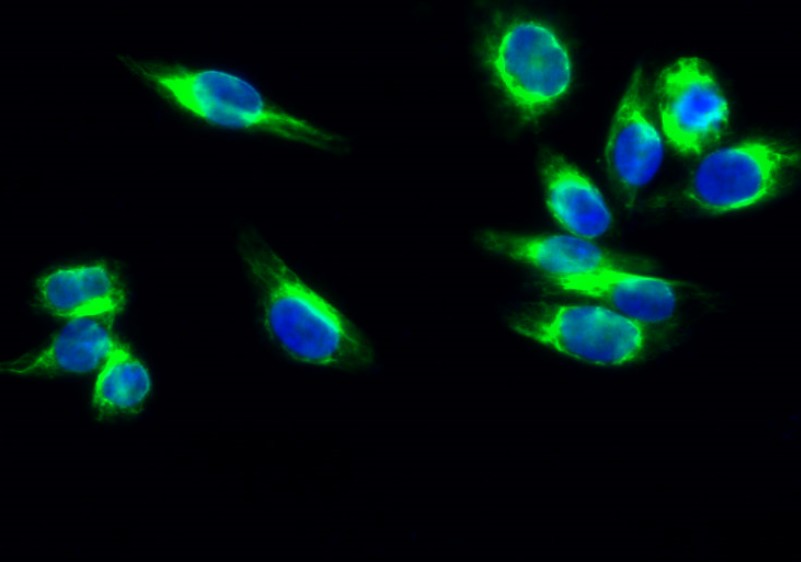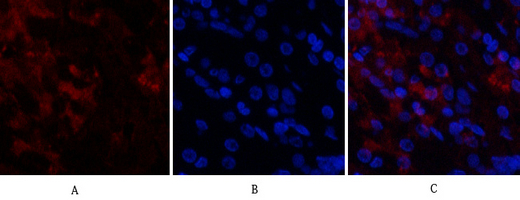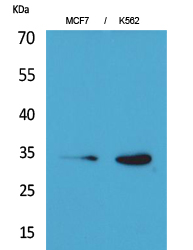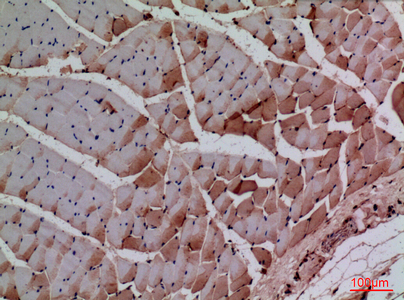Cdk4 Polyclonal Antibody
- Catalog No.:YT5198
- Applications:IF;WB;IHC;ELISA
- Reactivity:Human;Mouse;Rat
- Target:
- Cdk4
- Fields:
- >>Endocrine resistance;>>Cell cycle;>>p53 signaling pathway;>>PI3K-Akt signaling pathway;>>Cellular senescence;>>Tight junction;>>T cell receptor signaling pathway;>>AGE-RAGE signaling pathway in diabetic complications;>>Cushing syndrome;>>Hepatitis C;>>Measles;>>Human cytomegalovirus infection;>>Influenza A;>>Human papillomavirus infection;>>Human T-cell leukemia virus 1 infection;>>Kaposi sarcoma-associated herpesvirus infection;>>Epstein-Barr virus infection;>>Pathways in cancer;>>Viral carcinogenesis;>>Pancreatic cancer;>>Glioma;>>Melanoma;>>Bladder cancer;>>Chronic myeloid leukemia;>>Small cell lung cancer;>>Non-small cell lung cancer;>>Breast cancer;>>Hepatocellular carcinoma
- Gene Name:
- CDK4
- Protein Name:
- Cyclin-dependent kinase 4
- Human Gene Id:
- 1019
- Human Swiss Prot No:
- P11802
- Mouse Gene Id:
- 12567
- Mouse Swiss Prot No:
- P30285
- Rat Gene Id:
- 94201
- Rat Swiss Prot No:
- P35426
- Immunogen:
- The antiserum was produced against synthesized peptide derived from the N-terminal region of human CDK4. AA range:1-50
- Specificity:
- Cdk4 Polyclonal Antibody detects endogenous levels of Cdk4 protein.
- Formulation:
- Liquid in PBS containing 50% glycerol, 0.5% BSA and 0.02% sodium azide.
- Source:
- Polyclonal, Rabbit,IgG
- Dilution:
- IF 1:50-200 WB 1:500 - 1:2000. IHC: 1:100-300 ELISA: 1:20000. Not yet tested in other applications.
- Purification:
- The antibody was affinity-purified from rabbit antiserum by affinity-chromatography using epitope-specific immunogen.
- Concentration:
- 1 mg/ml
- Storage Stability:
- -15°C to -25°C/1 year(Do not lower than -25°C)
- Other Name:
- CDK4;Cyclin-dependent kinase 4;Cell division protein kinase 4;PSK-J3
- Observed Band(KD):
- 35kD
- Background:
- cyclin dependent kinase 4(CDK4) Homo sapiens The protein encoded by this gene is a member of the Ser/Thr protein kinase family. This protein is highly similar to the gene products of S. cerevisiae cdc28 and S. pombe cdc2. It is a catalytic subunit of the protein kinase complex that is important for cell cycle G1 phase progression. The activity of this kinase is restricted to the G1-S phase, which is controlled by the regulatory subunits D-type cyclins and CDK inhibitor p16(INK4a). This kinase was shown to be responsible for the phosphorylation of retinoblastoma gene product (Rb). Mutations in this gene as well as in its related proteins including D-type cyclins, p16(INK4a) and Rb were all found to be associated with tumorigenesis of a variety of cancers. Multiple polyadenylation sites of this gene have been reported. [provided by RefSeq, Jul 2008],
- Function:
- catalytic activity:ATP + a protein = ADP + a phosphoprotein.,disease:CDK4 mutations are involved in tumor formation.,disease:Defects in CDK4 are the cause of cutaneous malignant melanoma 3 (CMM3) [MIM:609048, 155600]. Malignant melanoma is a malignant neoplasm of melanocytes, arising de novo or from a preexisting benign nevus, which occurs most often in the skin but also may involve other sites.,enzyme regulation:Phosphorylation at Thr-172 is necessary for enzymatic activity.,function:Probably involved in the control of the cell cycle.,similarity:Belongs to the protein kinase superfamily. CMGC Ser/Thr protein kinase family. CDC2/CDKX subfamily.,similarity:Contains 1 protein kinase domain.,subunit:Forms a stable complex with D-type G1 cyclins. Interacts with SEI1 and ZNF655/VIK.,
- Subcellular Location:
- Cytoplasm . Nucleus . Nucleus membrane . Cytoplasmic when non-complexed. Forms a cyclin D-CDK4 complex in the cytoplasm as cells progress through G(1) phase. The complex accumulates on the nuclear membrane and enters the nucleus on transition from G(1) to S phase. Also present in nucleoli and heterochromatin lumps. Colocalizes with RB1 after release into the nucleus. .
- Expression:
- Brain,Muscle,
Sirtuin 7 promotes non‑small cell lung cancer progression by facilitating G1/S phase and epithelial‑mesenchymal transition and activating AKT and ERK1/2 signaling. ONCOLOGY REPORTS Oncol Rep. 2020 Sep;44(3):959-972 WB,IHC Human 1 : 1000,1:100 Lung cancer TMA section A549 cell, H292 cell
Final-2 targeted glycolysis mediated apoptosis and autophagy in human lung adenocarcinoma cells but failed to inhibit xenograft in nude mice. FOOD AND CHEMICAL TOXICOLOGY Food Chem Toxicol. 2019 Aug;130:1 WB Human A549 cell,SK-MEL-28 cell
Alterations in cyclin D1 and cyclin‑dependent kinase 4 expression in the amygdalae of post‑traumatic stress disorder rats. Molecular Medicine Reports Mol Med Rep. 2017 Dec;16(6):8351-8358 IF Rat 1:200 Amygdala tissue
Apigenin Combined With Gefitinib Blocks Autophagy Flux and Induces Apoptotic Cell Death Through Inhibition of HIF-1α, c-Myc, p-EGFR, and Glucose Metabolism in EGFR L858R+T790M-Mutated H1975 Cells. Frontiers in Pharmacology Front Pharmacol. 2019 Mar;0:260 WB Human H1975 cell
Notch3 is involved in the proliferation of renal cancer cells via regulation of cell cycle progression and HIF‑2α. Oncology Letters 2020 Dec 01 WB Human 1:1000 786-O cell, ACHN cell
Cong, Ming, et al. "Alterations in cyclin D1 and cyclin‑dependent kinase 4 expression in the amygdalae of post‑traumatic stress disorder rats." Molecular medicine reports 16.6 (2017): 8351-8358.
Final-2 targeted glycolysis mediated apoptosis and autophagy in human lung adenocarcinoma cells but failed to inhibit xenograft in nude mice. FOOD AND CHEMICAL TOXICOLOGY Food Chem Toxicol. 2019 Aug;130:1 WB Human A549 cell,SK-MEL-28 cell
Voacamine is a novel inhibitor of EGFR exerting oncogenic activity against colorectal cancer through the mitochondrial pathway PHARMACOLOGICAL RESEARCH Sanjun Shi WB Human
Kaempferol ameliorates pulmonary vascular remodeling in chronic hypoxia-induced pulmonary hypertension rats via regulating Akt-GSK3β-cyclin axis TOXICOLOGY AND APPLIED PHARMACOLOGY Dianxiang Lu WB Rat lung tissues Pulmonary arterial smooth muscle cells (PASMCs)
4-Terpineol attenuates pulmonary vascular remodeling via suppressing PI3K/Akt signaling pathway in hypoxia-induced pulmonary hypertension rats. Dianxiang Lu WB Rat 1:1000 lung tissue pulmonary arterial smooth muscle cells (PASMCs)
Bruceine A: Suppressing metastasis via MEK/ERK pathway and invoking mitochondrial apoptosis in triple-negative breast cancer. BIOMEDICINE & PHARMACOTHERAPY Jun Lu WB Mouse,Human 1:1000 MDA-MB-231 cell,4T1 cell
CADM1 impairs the effect of miR-1246 on promoting cell cycle progression in chemo-resistant leukemia cells. BMC CANCER Linjing Li WB Human 1:1000 Blood K562 cell,HL-60 cell
L-Theanine delays D-galactose-induced senescence by regulating the cell cycle and inhibiting apoptosis in rat intestinal cells JOURNAL OF THE SCIENCE OF FOOD AND AGRICULTURE Wei Xu WB Rat 1:2000 IEC-6 cell
- June 19-2018
- WESTERN IMMUNOBLOTTING PROTOCOL
- June 19-2018
- IMMUNOHISTOCHEMISTRY-PARAFFIN PROTOCOL
- June 19-2018
- IMMUNOFLUORESCENCE PROTOCOL
- September 08-2020
- FLOW-CYTOMEYRT-PROTOCOL
- May 20-2022
- Cell-Based ELISA│解您多样本WB检测之困扰
- July 13-2018
- CELL-BASED-ELISA-PROTOCOL-FOR-ACETYL-PROTEIN
- July 13-2018
- CELL-BASED-ELISA-PROTOCOL-FOR-PHOSPHO-PROTEIN
- July 13-2018
- Antibody-FAQs
- Products Images

- Immunofluorescence analysis of Hela cell. 1,Cdk4 Polyclonal Antibody(green) was diluted at 1:200(4° overnight). 2, Goat Anti Rabbit Alexa Fluor 488 Catalog:RS3211 was diluted at 1:1000(room temperature, 50min). 3 DAPI(blue) 10min.

- Immunofluorescence analysis of human-stomach tissue. 1,Cdk4 Polyclonal Antibody(red) was diluted at 1:200(4°C,overnight). 2, Cy3 labled Secondary antibody was diluted at 1:300(room temperature, 50min).3, Picture B: DAPI(blue) 10min. Picture A:Target. Picture B: DAPI. Picture C: merge of A+B

- Western Blot analysis of MCF7, K562 cells using Cdk4 Polyclonal Antibody. Secondary antibody(catalog#:RS0002) was diluted at 1:20000
.jpg)
- Immunohistochemical analysis of paraffin-embedded human-brain, antibody was diluted at 1:100

- Immunohistochemical analysis of paraffin-embedded rat-muscle, antibody was diluted at 1:100

- Western blot analysis of lysate from MCF7 cells, using CDK4 Antibody.



